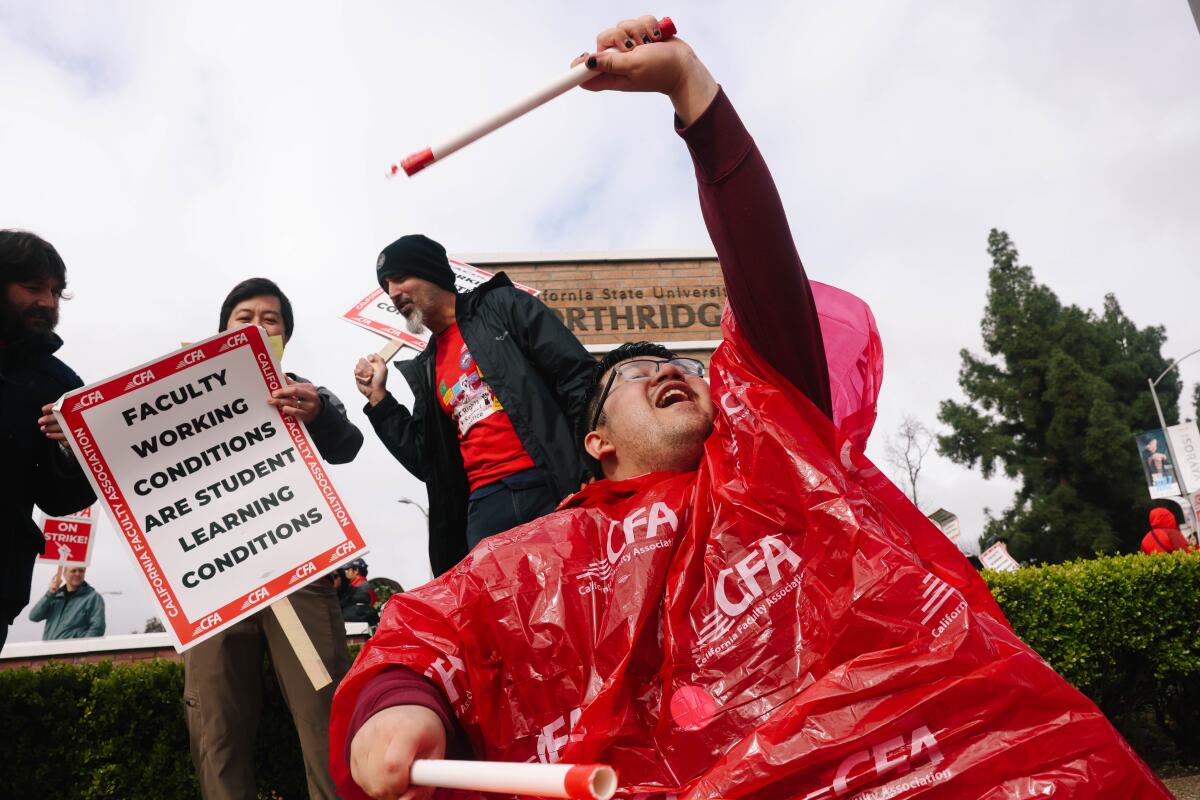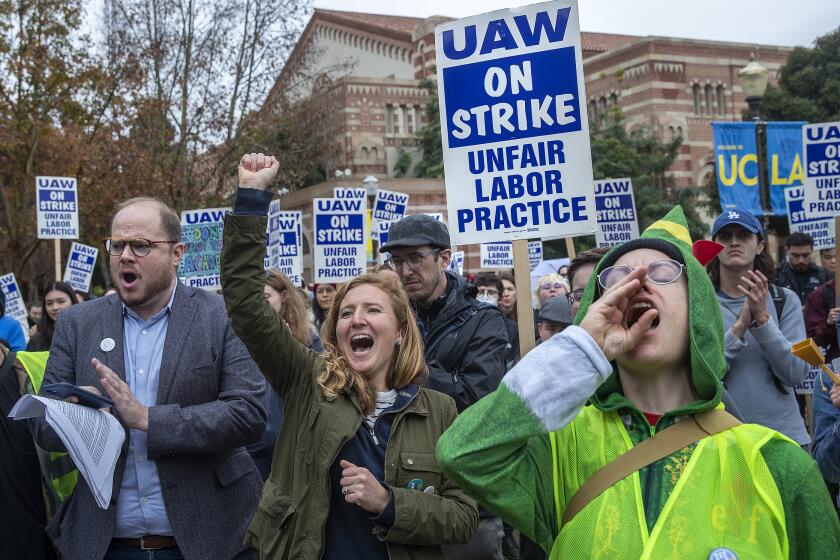Cal State and faculty union reach tentative pact with lightning speed, and not all are happy

- Share via
A tentative labor agreement between California State University and its faculty, reached with lightning speed after a one-day strike, drew mixed early reviews — but union leaders said Tuesday it provides major gains for the most underpaid instructors and other benefits.
The abrupt end to Monday’s strike among faculty at the nation’s largest four-year university system confused and disappointed some union members who were prepared for a one-week walkout intended to “shut down” campuses as they held out for better pay and benefits. The Monday-night agreement avoided a five-day disruption to the system’s 23 campuses during what was for most the first week of the new term. Faculty were to return to their classes Wednesday.
Charles Toombs, president of the California Faculty Assn., said raising minimum pay for the lowest-paid instructors, who make up more than half of the union’s 29,000 members, was a “massive and historic” win. He also touted the 10% general raise over two years and other benefits such as extended parental leave, union support dealing with police and more access to gender-inclusive restrooms and lactation spaces.
The union initially had pushed for an across-the-board increase of 12% in one year.
“We think there are major gains for everyone here and that this agreement is responsive to the majority of our members,” Toombs said.
CSU Chancellor Mildred Garcia also hailed the tentative agreement.
“I am extremely pleased and deeply appreciative that we have reached common ground with CFA that will end the strike immediately,” she said in a statement. “The agreement enables the CSU to fairly compensate its valued, world-class faculty while protecting the university system’s long-term financial sustainability.”
Toombs said CSU officials tied the tentative agreement to an immediate end to the strike. Union leaders felt obligated to give members the right to vote on what could be the administration’s last, best offer, he added. But Toombs said leaders would go back to the bargaining table if members reject the tentative agreement. No date has been set for a ratification vote.
The strike by professors, lecturers, counselors, librarians and coaches culminated months of increasing tension between the union and CSU administration. It was the latest California labor walkout in higher education and TK-12 school districts as faculty and other workers have demanded higher salaries amid escalating costs of living.
The massive and successful strike by University of California academic workers has helped energize an unprecedented surge of labor organizing among their peers nationwide.
Just over a year ago, about 48,000 University of California academic workers, teaching assistants, researchers and postdoctoral scholars walked out for about five weeks, ultimately winning significant improvements of in wages and working conditions — a labor action many expected to be a precursor for union empowerment nationally in higher education.
Several CSU faculty members expressed unhappiness with the union’s decision to accept the tentative agreement and call off the strike so quickly.
Leda Ramos, a CFA-LA Lecturer Council representative and a lecturer of Chicana(o) and Latina(o) studies at Cal State Los Angeles, said her chapter’s executive board will hold an emergency meeting Wednesday to hear from members.
“The decision is bringing forth a lot of shock … a lot of disagreement. We need to make sure we can hear people from the bottom to the top,” Ramos said. “There’s a lot of discontent ... because everything happened so quickly. We went from an optimal, statewide, shut-it-down strike and then, within 24 hours, it was over. We need to really reflect on and voice our opinions in our own union.”
But Ken Jacobs, a professor and co-chair of the UC Berkeley Labor Center, said the union was justified in celebrating a major step forward.
“The union’s message — that strikes work — I think was spot on,” Jacobs said. “Well-organized strikes with high participation have an impact.” While the union did not attain all its demands, “it appears they made significant progress.”
Jacobs sees the CSU action as part of a continuum of largely successful strikes in recent years with a “key emphasis on bringing up the bottom of the scale, really addressing the differentiation between employees, but also just how hard it is for people to live on that lower pay.”
Coming after an era in which unions accepted two-tier contracts — with worse terms for newcomers — “this is a welcome and important change, and a recognition that it’s better for all workers when you bring the bottom of that scale up.”
The 2022 UC academic workers strike also resulted in a new contract that significantly boosted the wages of the lowest-paid workers.
Virginia Parks, faculty director of UC Irvine Labor Center, noted that the tiered structure was “front and center” as a bargaining issue for the United Auto Workers in the fall. “They’re seeing increasing inequality in their ranks, and it’s bad for morale and bad for education,” Parks said.
She traced the trend of strikes among faculty at TK-12 school districts to before the COVID-19 pandemic.
“In 2018, we had the highest number of workers on strike since 1986. And that was predominantly driven by those teacher strikes,” Parks said. “So we’re seeing an extension of strikes by workers in education, who are facing very, very similar issues: larger class sizes, stagnating wages and a call for not only bread-and-butter issues at the bargaining table but also bargaining for a more collective good. And I think you see that in this kind of agreement.”
Stanford emeritus law professor William B. Gould IV was less impressed by the CSU outcome.
“It strikes me as a modest agreement considering where the parties were and the kinds of agreements being entered into in both the public and private sectors,” said Gould, a former chair of the National Labor Relations Board. “It has a look that is going to cause some difficulties for the union in selling this agreement.”
One underwhelmed faculty member is Emily Berquist Soule, a 16-year history professor at Cal State Long Beach. She said she was “disappointed” with the tentative pact and had been prepared for a longer strike that would push toward meeting the union’s stronger demands.
“We put forth so much effort and got so much support from our students, our communities and our local union chapters to disrupt the first day of classes, disrupt our lives and potentially our pay,” Berquist said. “My personal preference, of course, would have been to get the full amount that we were asking for.”
Berquist plans to resume teaching Wednesday, though she said it’s unclear how many students will be back in class after the announcement of a weeklong cancellation.
“If our working conditions are unsustainable, if the majority of us have to have second jobs — and this is including tenured faculty — in order to make ends meet, we can’t serve our students the way that they deserve,” she said.
Students, too, were shocked that the tentative agreement was reached so quickly.
“It came out of left field,” Cal State Channel Islands student Courtland Briggs said. “We all expected this would last a week. It only lasted a day — then we got an email at 10.”
During week-long, rolling walk-outs at four California State University campuses, faculty highlighted the tenuous working conditions of lecturers, who are a backbone of instruction but ineligible for tenure.
Briggs, 24, said it has been a scramble for students to shift their schedules so suddenly. He had doctors appointments planned this week that he’ll have to move around, and his friends who have hours-long commutes are racing to get back to town.
Kendall Ward, 21, a fourth-year student at Sacramento State, also said she was surprised but would continue to support faculty in whatever decision they make.
Ward, 21, plans to go back to classes this week and said she would continue talking with faculty about their perspective on the deal.
“I think the main thing I’ve learned here is that faculty conditions are student learning conditions,” Ward said.
CSU students and faculty also took to social media to voice concerns. Among them, the agreement does not include hard commitments to improve the counselor-to-student ratio, at a time of widespread mental health needs. Instead, the university and union agreed to what Toombs called an “aspirational goal” to bring CSU up to the national average of 1,500 students for each counselor.
“This feels like a betrayal rather than a victory,” one person wrote on Instagram.
The tentative agreement includes:
• A 5% salary increase for all faculty, retroactive to July 1, 2023, and another 5% increase on July 1 of this year continent on adequate state funding. The union had pushed for an across-the-board, 12% wage increase for the 2023-24 academic year.
• A higher salary floor for the union’s lowest-paid faculty members. Minimum pay for lecturers with master’s degrees — but not the highest degree offered in their field, such as doctorate — would increase from $54,300 to $66,000 over two years. Pay for lecturers with the highest degree in their field would rise from $64,800 to $75,000.
• An extension of paid parental leave from six to 10 weeks. The union wanted a semester of leave, 15 or 16 weeks.
• Access to a union representative in dealings with campus police.
• Expanded access to gender-inclusive restrooms and lactation spaces.
More to Read
Sign up for Essential California
The most important California stories and recommendations in your inbox every morning.
You may occasionally receive promotional content from the Los Angeles Times.


















